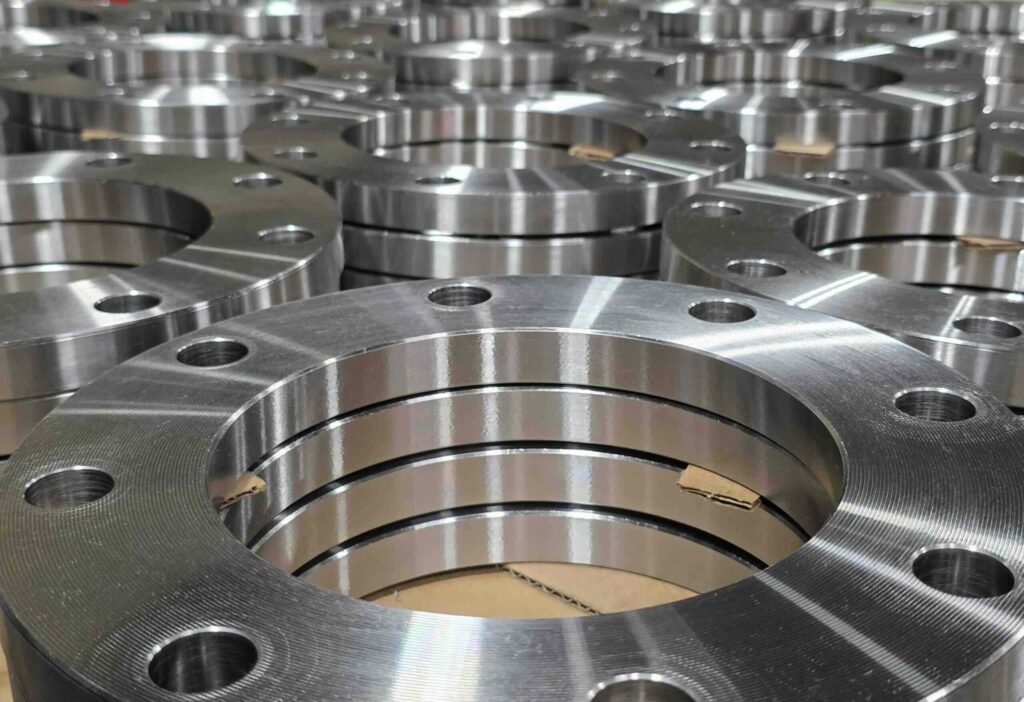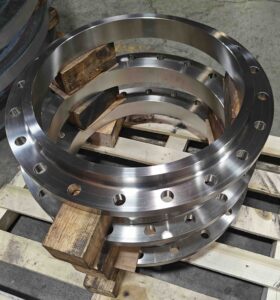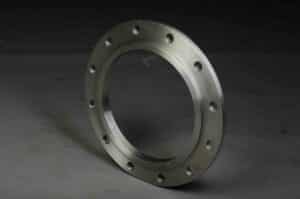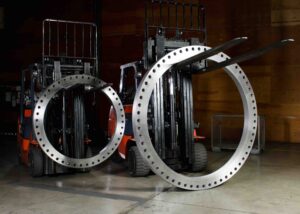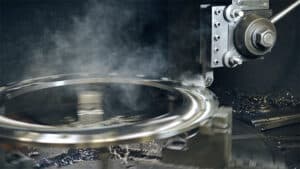The material selected for a flange encompasses several key factors, including performance, reliability, and longevity. The choice of flange material must suit the operating conditions, which include temperature, pressure, fluid chemistry, mechanical loading, and environmental exposure. In this article, we present an overview of common flange materials, discuss their properties, advantages, limitations, and typical applications. The materials are arranged roughly in the order of their industrial prevalence and specialization:
- Carbon Steel
- Stainless Steel
- Alloy Steel
- Cast Iron / Ductile Iron
- Specialized Materials (Nickel Alloys, Duplex / Super Duplex, Aluminum, Titanium, Copper-Nickel and Plastics)
1. Common Flange Materials
Description & Grades
Carbon steel is often the “default” choice for flanges in many general industrial applications. It is composed primarily of iron with a modest carbon content and sometimes minor alloying additions. Typical flange standards employ carbon steel grades such as ASTM A105 (for forged flanges) or ASTM A36 (for low-carbon steels for certain temperature services).
Types of Common Carbon Steels Used for Flanges:
| Type | Common Grades | Carbon Content | Notes |
|---|---|---|---|
| Mild / Low Carbon Steel | ASTM A36, Q235 | 0.05–0.30% | Most widely used. Good machinability, ductility, and weldability. |
| Medium Carbon Steel | ASTM A105 | 0.30–0.50% | Stronger than mild steel, used in forged flanges and pressure applications. |
| High Carbon Steel | AISI/SAE 1060–1095 series | 0.60–1.00% | Very strong and hard, but less ductile. Materials are not recommended for flanges. |
| Ultra-High Carbon Steel | W1 and T10 | 1.00–2.00% | Extremely hard and brittle. Materials are not recommended for flanges; they are more common in specialized tooling. |
Advantages
- Good mechanical strength under moderate temperature regimes
- Relatively low cost and plentiful availability
- Well understood in design codes, fabrication practice, and standardization
- Fair weldability and machinability
Limitations / Considerations
- Poor inherent corrosion resistance: requires painting, coatings, or corrosion protection
- Not ideal for highly corrosive fluids or aggressive chemical environments
- At elevated temperatures, carbon steel may suffer creep, embrittlement, phase changes, oxidation, or plasticity
- At low temperatures, impact toughness must be considered (so special low-temperature grades may be required)
Typical Applications
- Used extensively in oil & gas, water systems, steam lines, HVAC, and general industrial piping where conditions are moderate and corrosion is manageable.
Description & Grades
Stainless steels include a range of chromium-nickel (and sometimes molybdenum) alloys with high corrosion resistance. Common grades for flanges are 304L, 316L. The “L” indicates low carbon to reduce carbide precipitation during welding.
- 304 Stainless Steel – General-purpose grade with good corrosion resistance and strength.
- 304L Stainless Steel – Low carbon content for improved weldability and higher corrosion resistance.
- 316 Stainless Steel – Includes nickel and molybdenum for added protection against chlorides and high-temperature exposure.
- 316L Stainless Steel – Low carbon version of 316 with enhanced weldability and resistance in aggressive environments.
- High Carbon Variants (304H, 316H) – Offer higher tensile strength at elevated temperatures.
- Dual Grades (304/304L, 316/316L) – Higher strength grades, with lower Carbon content, meet the material requirements of more than one standard, such as AWWA C228, for broader application use.
Advantages
- Excellent resistance to corrosion and oxidation in different environments
- Suitable for chemical, marine, desalination, and offshore environments
- Good mechanical properties across a moderate temperature range
- Lower upkeep, as external coatings are often unnecessary
Limitations / Considerations
- Higher material cost compared to carbon steel
- Fabrication and welding must be carefully controlled to avoid sensitization or deleterious phases
- In extremely high-temperature or highly aggressive environments, stainless steel may still fall short
Typical Applications
- Flanges in chemical processing, petrochemical, marine, desalination, and corrosive service conditions.
1.3 Cast Iron
Description & Grades
Cast iron flanges are produced from iron-based materials that can include gray iron or ductile iron. These materials vary in their mechanical properties depending on the graphite structure and manufacturing process. Gray cast iron is the most traditional and economical option, while ductile iron provides improved strength and toughness. Cast iron flange “ratings” are generally defined by pressure classes. Standards such as ANSI/ASME B16.1 cover gray cast iron flanges, most commonly in Class 125 and Class 250. For ductile iron flanges, ASME B16.42 specifies Class 150 and Class 300. ASTM A126 and ASTM A48 standards define gray iron grades by tensile strength, which relates to material properties, rather than flange pressure ratings. ASTM A536 standard defines ductile iron grades.
Advantages
- Lower cost than many steels when loads are modest
- Good stiffness and compressive strength
- In ductile iron, improved toughness and fatigue resistance compared to gray iron
Limitations / Considerations
- Poor tensile strength and brittleness (especially in gray iron)
- Weak corrosion resistance; typically used with coatings
- Limited pressure and temperature ratings
- Cast flanges and ductile flanges may require care in matching face types (flat, raised, etc.) when connecting to steel flanges
Typical Applications
- Water and wastewater systems, low-pressure piping, infrastructure, municipal utilities.
2. Specialized Materials
Description & Grades
Alloys are critical in many industries, from construction and manufacturing to aerospace and automotive. Combining two or more elements, where at least one is a metal, alloys are designed to enhance strength, corrosion resistance, and conductivity. Below is a detailed look at some of the most common alloys, their properties, and their applications.
| Alloy / Type | Key Properties | Common Grades / Variants | Typical Applications (incl. Flanges) |
|---|---|---|---|
| Low Alloy Carbon Steel | High tensile strength, ductility, and weldability | ASTM A350 (Grade LF2, LF6, LF3) | General piping flanges, industrial machinery, structural systems |
| Low-Carbon Nickel-Chromium-Molybdenum | High Corrosion resistance | Inconel C-276 (ASTM B575, ASTM B462 (UNS N10276)) | Used where both corrosion resistance and weld integrity are crucial. Used in acidic chemical service, offshore oil & gas, seawater exposure, and pollution control |
| Ferritic-Austenitic Stainless Steels | High Tensile Strength, High Corrosion Resistance | Super Duplex (Zeron 100, ASTM A182 F55 (UNS S23760)) | Used where chlorides, high pressure, or aggressive chemicals are present |
| Austenitic Stainless Steel | High tensile strength, ductility, hardness (by cold working) | Stainless (304/316/304L/316L), Tool Steel | Anywhere corrosion resistance, hygiene, and durability are needed, especially in chemical, marine, food-grade, and high-purity systems |
| Aluminum Alloys | Lightweight, corrosion resistant, good conductivity, strong strength-to-weight | 2024 (high strength), 6061 (balanced), 7075 (durable, high-strength) | Lightweight piping, irrigation, aerospace, transport |
| Brass (Cu + Zn) | Malleable, corrosion resistant, conductive, antimicrobial | Alpha Brass, Beta Brass, Leaded Brass | Decorative flanges, fittings, plumbing, low-pressure components |
| Bronze (Cu + Sn) | Tough, seawater corrosion resistance, non-magnetic, machinable | Phosphor Bronze, Aluminum Bronze | Marine flanges, pump parts, bearings, valves |
| Nickel Alloys | Corrosion resistance, high strength, fabricability, and fracture toughness | Inconel 625 (ASTM B564 (UNS N06625)) | High-temp, chemical plants, marine, aerospace |
| Titanium Alloys | High strength-to-weight, biocompatible, corrosion resistant | Grade 2 (chem. resistance), Grade 5 (Ti-6Al-4V) | Aerospace, medical, marine, desalination flanges |
| Magnesium Alloys | Ultra-lightweight, good heat dissipation, strength-to-weight ratio | Mg-Al, Mg-Zn, Mg-rare earth alloys | Lightweight aerospace/automotive components, specialty flanges |
2.2 Nickel Alloys (Inconel, Monel, Hastelloy, etc.)
Description & Grades
Nickel-based alloys are designed for extreme conditions: high temperatures, aggressive corrosion, oxidation, and combined stress. A well-known example is Inconel 625 (Ni-Cr-Mo-Nb alloy). Monel, Hastelloy, and other nickel alloys also find flange use in demanding environments.
Advantages
- High corrosion resistance in harsh chemical environments
- Strong mechanical stability at high temperature (creep resistance, oxidation resistance)
- Suitable for sour environments and aggressive media
Limitations / Considerations
- Very high cost
- Difficult machining and welding (nickel alloys tend to work-harden)
- Fabrication requires special expertise
Typical Applications
- Chemical processing, offshore, subsea, high-temperature reactors, and systems exposed to aggressive fluids.
2.3 Duplex / Super Duplex Steels
Description & Grades
For duplex flanges, the common grade is 2205, while for super duplex flanges it is the grade 2507. Duplex 2205 and super duplex 2507 stainless steels are widely used flange materials, offering roughly twice the yield strength of common stainless steel grades like 304 and 316. Super Duplex 2507 provides even greater corrosion resistance. Both grades are commonly applied in chemical processing, petrochemical, power, and seawater systems, though service temperatures should remain below 570 °F (300 °C) to avoid embrittlement.
Advantages
- Higher yield strength than standard austenitic stainless (~2×)
- Excellent resistance to pitting, crevice corrosion, and stress corrosion cracking
- Cost-effective compared to nickel-based alloys
Limitations / Considerations
- More expensive than “ordinary” stainless steel
- Fabrication and welding require careful control to maintain duplex balance
- At very high temperatures, performance might degrade
Typical Applications
- Marine, offshore, desalination, chemical, oil & gas (especially where chloride attack is present)
2.4 Aluminum
Description & Properties
Aluminum flanges are valued for their light weight, corrosion resistance, and ease of machining. The most common alloy used is 6061-T6, which combines good strength, weldability, and resistance to many environments. Higher-strength grades such as 7075 exist but are less common for flanges. Aluminum flanges are covered under ASTM B247, which specifies forged or machined aluminum-alloy products used in pressure systems.
Advantages
- Very low weight compared to other flange materials
- Decent corrosion resistance
- Easier to work with and install
Limitations / Considerations
- Lower strength than steels
- Not suitable for high temperatures or pressures
- Susceptible to galvanic corrosion if in contact with dissimilar metals
- Less common in heavy industrial piping
Typical Applications
- Lightweight systems, aircraft, irrigation, HVAC, low-pressure fluid systems, and sometimes marine secondary systems.
2.5 Titanium
Description & Properties
Titanium flanges are standardized under ASTM B381, which covers forged titanium and titanium-alloy flanges used in pressure systems. The most common grades are Grade 2 (commercially pure titanium) and Grade 5 (Ti-6Al-4V). Grade 2 offers excellent corrosion resistance in seawater, chlorides, and chemical environments, making it ideal for marine and process industries. Grade 5 provides much higher strength while maintaining good corrosion resistance, making it the preferred alloy for aerospace and high-performance applications.
Advantages
- Very high strength-to-weight ratio
- Excellent corrosion resistance in seawater and chemical processing environments
- Long service life in harsh and chloride-rich conditions
- Biocompatible, enabling use in specialized industries
Limitations / Considerations
- Much more expensive than steel or stainless steel flanges
- More difficult to machine and fabricate compared to steels
- Risk of embrittlement if exposed to prolonged high temperatures above ~570 °F (300 °C)
Typical Applications
- Offshore oil & gas systems, desalination plants and seawater intake systems, chemical processing industries, aerospace and defense piping systems
2.6 Plastics / Thermoplastics
Description & Materials
Flanges made of plastics (e.g. PVC, PP, CPVC, PVDF) are used when chemical corrosion is a prime concern and mechanical or thermal demands are low.
Advantages
- Corrosion resistance to acids, alkalis, salts, and many chemicals
- Low cost, lightweight, and easy to fabricate or install
- No need for external coatings
Limitations / Considerations
- Limited pressure and temperature ratings
- Lower mechanical strength
- Concern under cyclic loads, thermal cycling, or when mechanical strength is needed
Typical Applications
- Chemical waste piping, water treatment, corrosive chemical services, and moderate-pressure systems in less demanding environments.
3. Summary Table
| Material / Class | Key Grades / Examples | Performance Characteristics | Typical Application Domains |
|---|---|---|---|
| Carbon Steel | ASTM A105, A36 | Good strength up to ~425 °C; low corrosion resistance, needs coatings or protection | Oil & gas, steam, water, HVAC, general industry |
| Stainless Steel | 304L, 316L, F55 (UNS S23760) | High corrosion resistance; good strength across moderate temps | Chemical, food, marine, offshore, desalination |
| Alloy Steel | Different types of alloys | Excellent strength and creep resistance at high temps; moderate corrosion resistance | Power plants, refineries, high-temp steam service |
| Cast / Ductile Iron | ASTM A126 and A48 (cast), ASTM A536 (ductile) | Adequate strength for low-pressure; ductile iron tougher; poor corrosion resistance | Water, wastewater, utilities, low-pressure piping |
| Nickel Alloys | Inconel 625, Monel 400, Hastelloy | Outstanding high-temp and corrosion resistance; stable under stress and harsh chemicals | Offshore, subsea, chemical, high-temp reactors |
| Duplex / Super Duplex | 2205, 2507 | Very high strength; excellent resistance to chlorides and stress corrosion cracking | Marine, oil & gas, subsea, desalination |
| Aluminum | 6061-T6, ASTM B247 | Lightweight; moderate corrosion resistance; limited strength/temp | Irrigation, HVAC, lightweight piping |
| Titanium | ASTM B381 | Excellent seawater resistance; high strength-to-weight; good corrosion performance | Marine, desalination, aerospace, heat exchangers |
| Plastics | PVC, PP, CPVC, PVDF | Corrosion-proof to many chemicals; limited pressure and temp; low mechanical strength | Water treatment, chemical waste, low-pressure flow |
4. Conclusion
In practice, when selecting a material for flanges, engineers must consider the full service envelope: pressure, temperature, fluid chemistry, mechanical loads, fatigue/cyclic service, fabrication constraints, and lifecycle cost. The ideal flange material is the one that meets performance requirements reliably while balancing cost, manufacturability, and compatibility with the piping system. Our sales team at API can answer any questions about your flange requirements. Depending on its application, they can also recommend alternative products that may be better suited for your system. We also provide custom flange solutions tailored to your project specifications. Get connected with a dedicated sales representative today! Or call us: 503.692.3800

